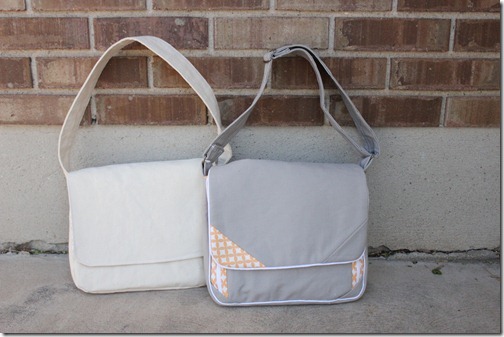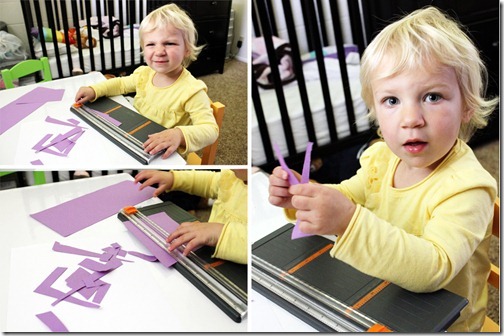
Apparently cutting paper is super fascinating and fun. Hailey loved it! I think we need to invest in her own pair of scissors.


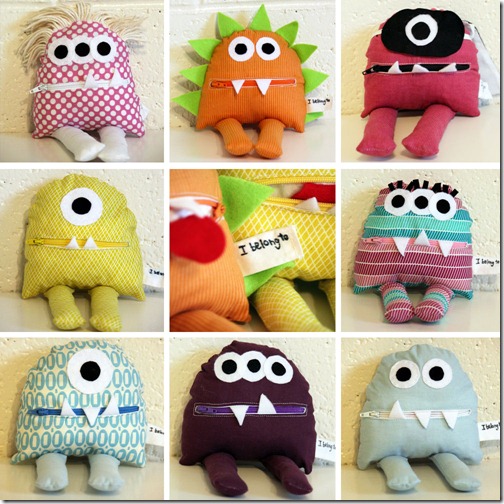 The Munster Bunch
The Munster Bunch 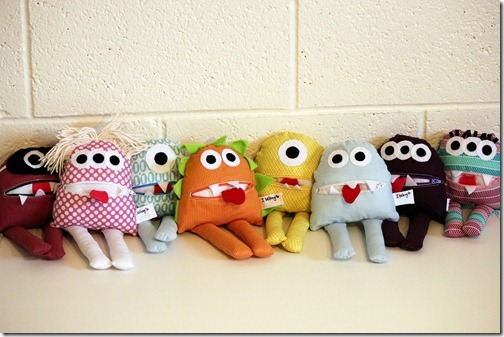
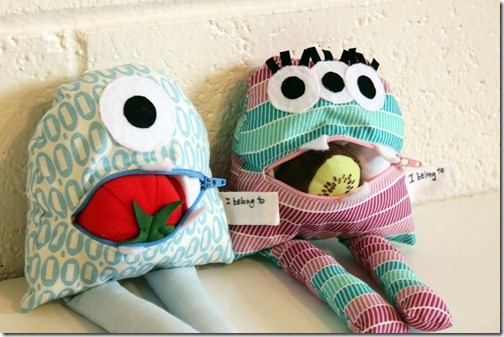
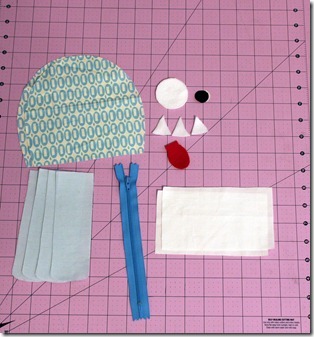 First cut out your pattern, pin it to the fabric, cut out fabric, and iron on wonder under to the backs of the eye pieces (leave the paper backing on for now.)
First cut out your pattern, pin it to the fabric, cut out fabric, and iron on wonder under to the backs of the eye pieces (leave the paper backing on for now.) 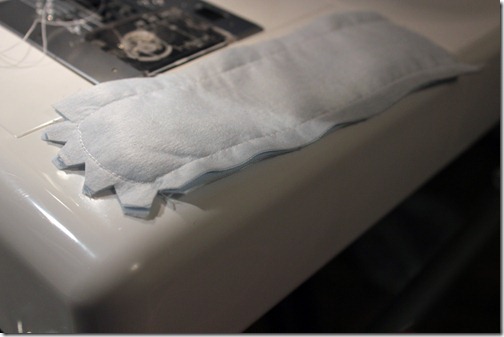 Starting with your leg pieces, sew with right sides together, down the sides and around the bottom curve. Leave the top open for stuffing. Notch the rounded edge.
Starting with your leg pieces, sew with right sides together, down the sides and around the bottom curve. Leave the top open for stuffing. Notch the rounded edge.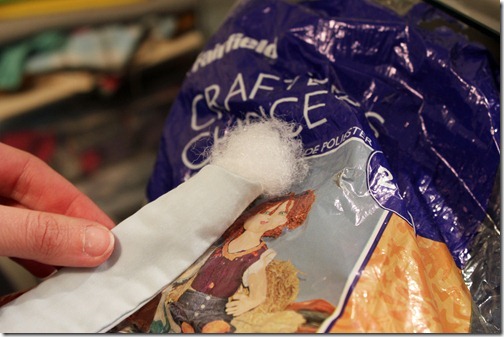 Iron the legs to smooth them out. Stuff them with fiberfill. Set them aside for now.
Iron the legs to smooth them out. Stuff them with fiberfill. Set them aside for now. Peel the paper backing off the wonder under on the eye pieces. Iron them to the body placing the white part about 1 inch down from the center and 2 inches from either edge.
Peel the paper backing off the wonder under on the eye pieces. Iron them to the body placing the white part about 1 inch down from the center and 2 inches from either edge.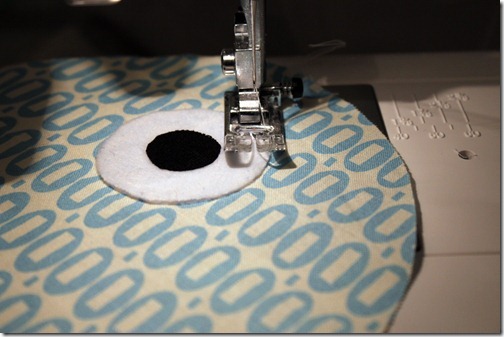 Stitch around both eye pieces to secure them in place, and to add a little detail. Machine or hand stitch. I was able to machine stitch one, but then ran into troubles after that and gave in to hand stitching the rest. I’m pretty sure this was because I used fusible backing that is no-sew, so it’s extra strong and gunks up the machine. I knew it was a no-no, but tried anyway. Don’t do it. Follow the instructions on whatever kind you buy.
Stitch around both eye pieces to secure them in place, and to add a little detail. Machine or hand stitch. I was able to machine stitch one, but then ran into troubles after that and gave in to hand stitching the rest. I’m pretty sure this was because I used fusible backing that is no-sew, so it’s extra strong and gunks up the machine. I knew it was a no-no, but tried anyway. Don’t do it. Follow the instructions on whatever kind you buy.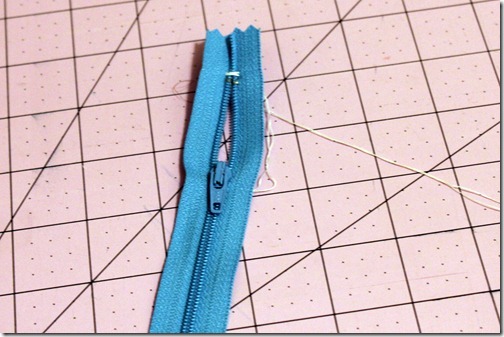 Grab your zipper. Unzip it just a little bit and tack it just past the metal stopper parts.
Grab your zipper. Unzip it just a little bit and tack it just past the metal stopper parts.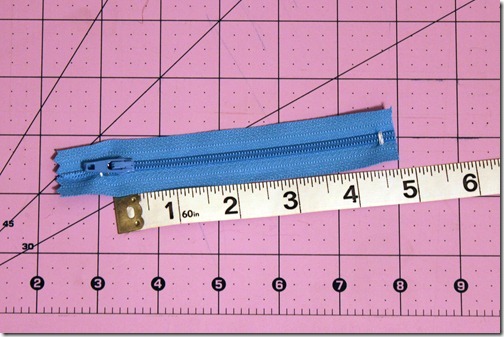 From the metal beginning part (so technical- I know…) of the zipper, measure 4.5 inches and tack the zipper just barely past that. Cut the zipper just a little past the tack.
From the metal beginning part (so technical- I know…) of the zipper, measure 4.5 inches and tack the zipper just barely past that. Cut the zipper just a little past the tack.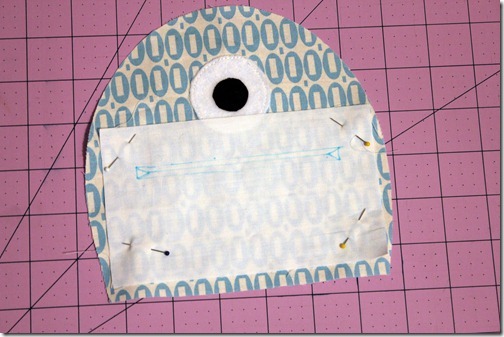 Now we’re going to make our zipper hole. Take one of your pocket pieces, place it right side up. Draw a box that is 4 1/2 inches wide and 1/4 inch tall. It will 7/8 inch down from the top and 3/4 inch from either edge. (I’m pretty sure it ends up being 4 1/2 inches, but just in case, just measure from the sides and draw your line and it’ll work.) Inside the box, mark a point in the center that is 1/4 inch from either edge of the box. Draw a diagonal line from there to each corner. Then draw a line connecting those two points. I know I didn’t describe that well. It should look like it does in the picture when you’re done. Pin the pocket piece in place approx. 3/8 inch above the bottom of the body piece.
Now we’re going to make our zipper hole. Take one of your pocket pieces, place it right side up. Draw a box that is 4 1/2 inches wide and 1/4 inch tall. It will 7/8 inch down from the top and 3/4 inch from either edge. (I’m pretty sure it ends up being 4 1/2 inches, but just in case, just measure from the sides and draw your line and it’ll work.) Inside the box, mark a point in the center that is 1/4 inch from either edge of the box. Draw a diagonal line from there to each corner. Then draw a line connecting those two points. I know I didn’t describe that well. It should look like it does in the picture when you’re done. Pin the pocket piece in place approx. 3/8 inch above the bottom of the body piece.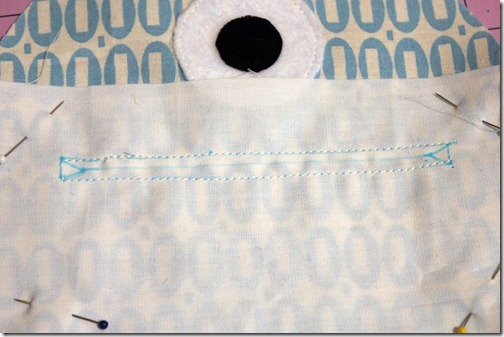 Stitch around the box you drew.
Stitch around the box you drew.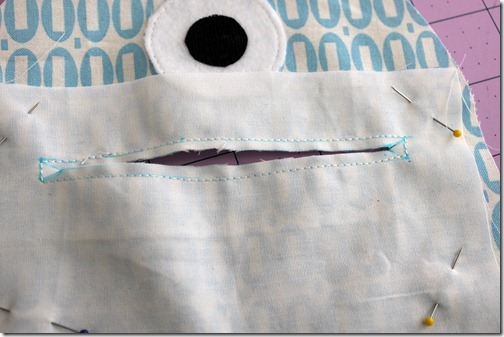 Cut on the inner lines. At the end triangles, cut up to the corners where you sewed, but be super careful not to cut through the stitching!
Cut on the inner lines. At the end triangles, cut up to the corners where you sewed, but be super careful not to cut through the stitching!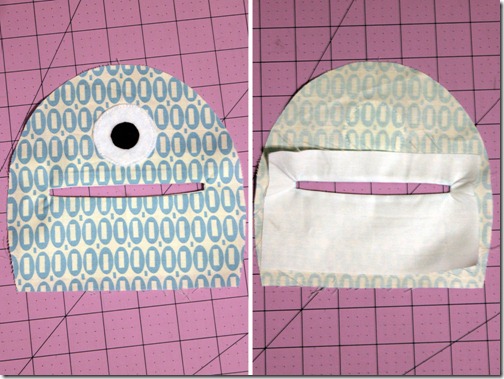 Push the pocket piece through the hole and press as flat and neat as you can. (Front and back views shown)
Push the pocket piece through the hole and press as flat and neat as you can. (Front and back views shown)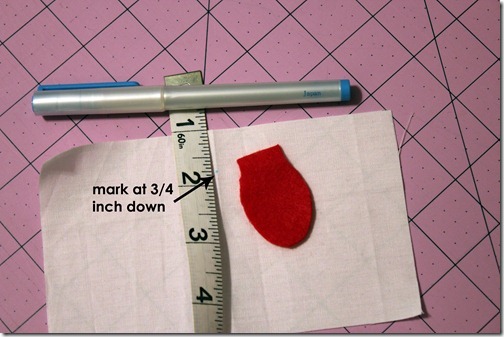 Take your other pocket piece and on the right side make a mark 3/4 inch down and centered. I folded the piece in half to find the center.
Take your other pocket piece and on the right side make a mark 3/4 inch down and centered. I folded the piece in half to find the center.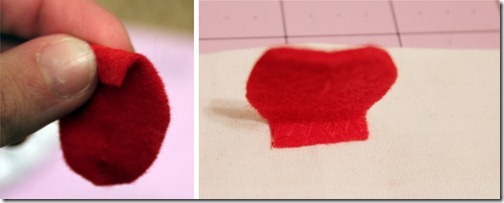 On the tongue piece there is a part that straightens out on the top. Fold this part down, like in the picture. Line up the top of the tongue, where the fold is, with the dot you just made on the pocket piece. Sew the tongue on using a zig-zag stitch.
On the tongue piece there is a part that straightens out on the top. Fold this part down, like in the picture. Line up the top of the tongue, where the fold is, with the dot you just made on the pocket piece. Sew the tongue on using a zig-zag stitch. 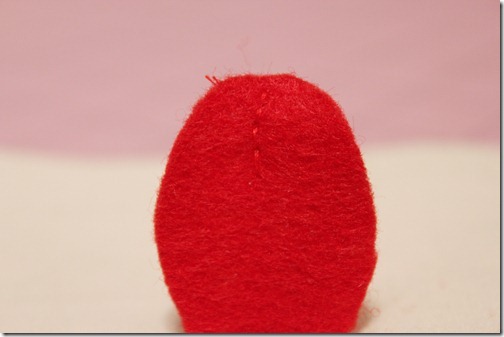 Hand stitch a few stitches onto the center bottom of the tongue to add a little detail.
Hand stitch a few stitches onto the center bottom of the tongue to add a little detail.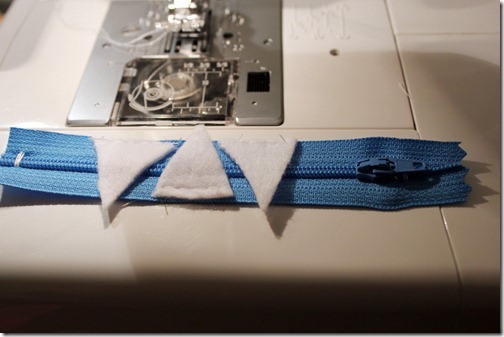 Baste the teeth onto the zipper however you want to place them.
Baste the teeth onto the zipper however you want to place them.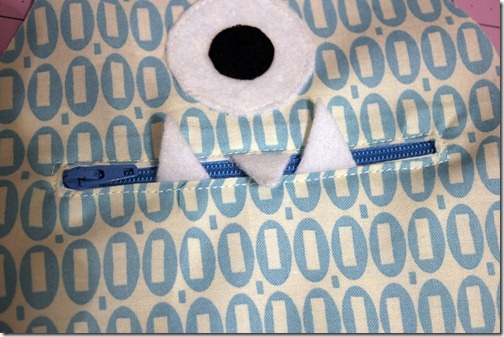 Place the zipper in the hole you cut out a few steps back. Using a zipper foot, topstitch around the edge of the zipper to secure it in place. Be sure not to sew over the teeth!
Place the zipper in the hole you cut out a few steps back. Using a zipper foot, topstitch around the edge of the zipper to secure it in place. Be sure not to sew over the teeth!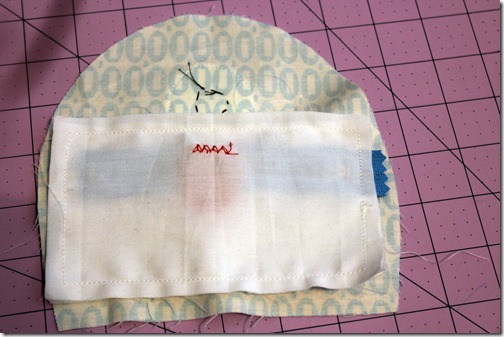 Turn the body piece over and with right sides together, line up your other pocket piece with the one that is stitched to the zipper. Sew a 3/8 inch seam all around. Now you have a zipper pocket!
Turn the body piece over and with right sides together, line up your other pocket piece with the one that is stitched to the zipper. Sew a 3/8 inch seam all around. Now you have a zipper pocket!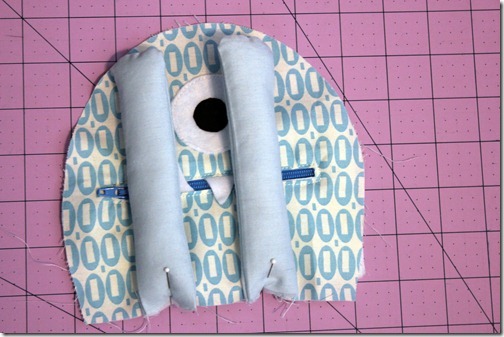 Pin or baste the legs (approx. 1 1/4 inches from the edges) onto the front body piece. I pinned in the picture, but after making a few switched to basting and liked that better. Just don’t forget to shorten your stitch length after basting- I did that one too many times.
Pin or baste the legs (approx. 1 1/4 inches from the edges) onto the front body piece. I pinned in the picture, but after making a few switched to basting and liked that better. Just don’t forget to shorten your stitch length after basting- I did that one too many times.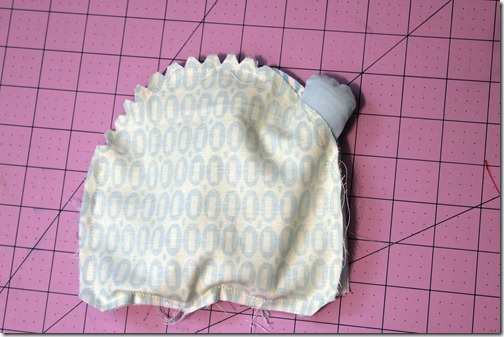 With right sides together, sew the back body piece to the front piece. Be sure to leave an opening a few inches wide so you can turn it right side out (mine is where the leg is sticking out.) Clip the corners and notch the curve.
With right sides together, sew the back body piece to the front piece. Be sure to leave an opening a few inches wide so you can turn it right side out (mine is where the leg is sticking out.) Clip the corners and notch the curve. Turn it right side out.
Turn it right side out.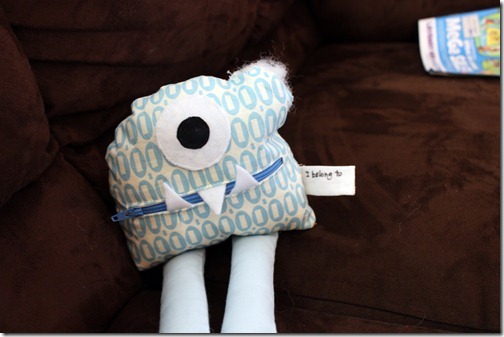 Stuff your monster.
Stuff your monster.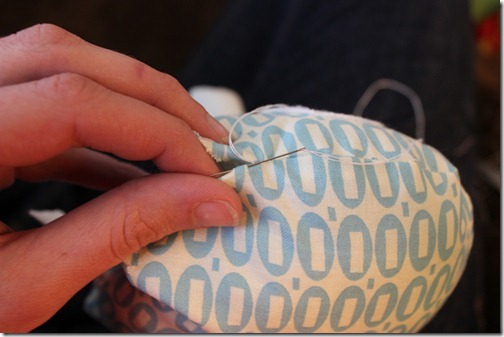 Hand stitch the opening closed. I don’t know what the stitch I’m using is called. It’s the same stitch I use to sew on binding onto a quilt. Slip the needle into the top of the crease and pull through. Then directly across it on the other side do the same thing. So where your needle left the fabric will line up with where your needle enters the fabric on the other side, so you’re moving in a forward motion. Confusing? Yeah, sorry.
Hand stitch the opening closed. I don’t know what the stitch I’m using is called. It’s the same stitch I use to sew on binding onto a quilt. Slip the needle into the top of the crease and pull through. Then directly across it on the other side do the same thing. So where your needle left the fabric will line up with where your needle enters the fabric on the other side, so you’re moving in a forward motion. Confusing? Yeah, sorry.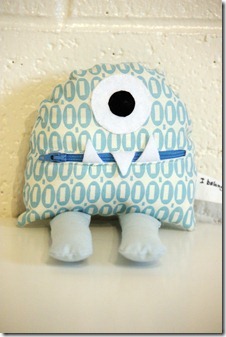 Now you’re done! Yay!
Now you’re done! Yay!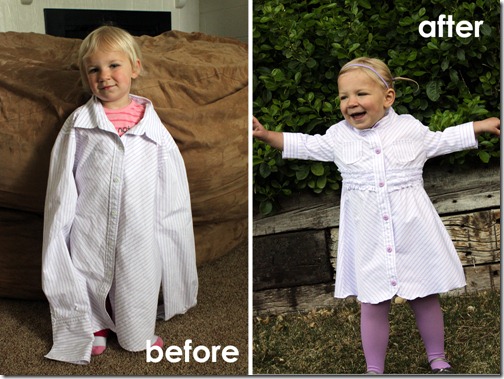
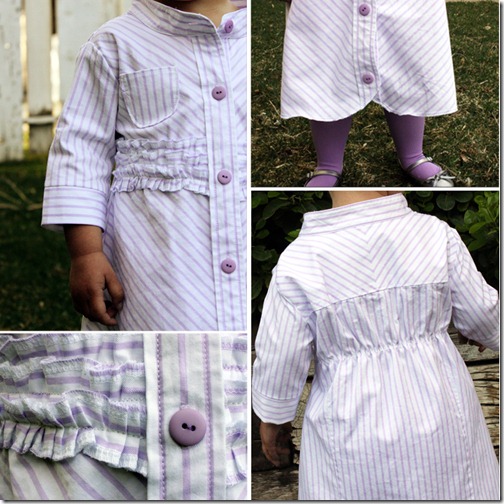
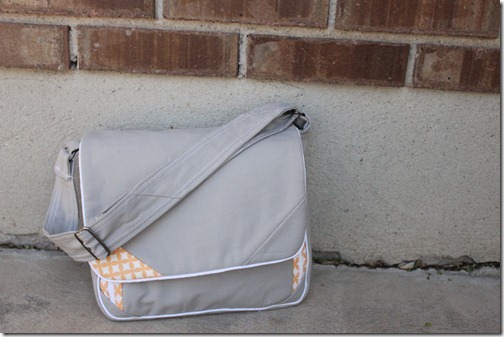
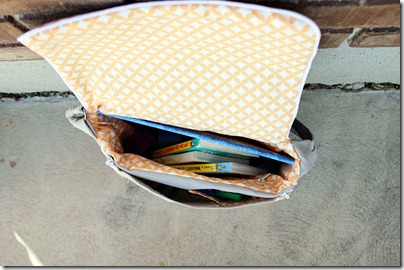
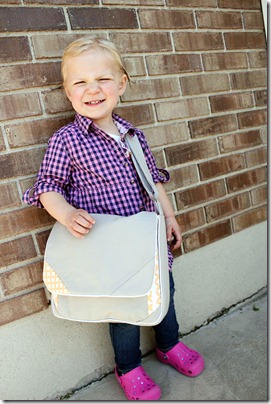
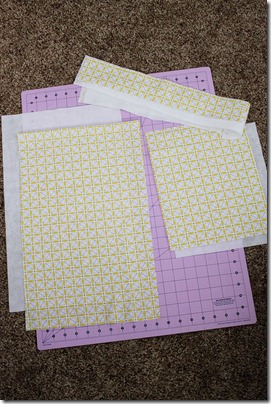 Pictured are my pieces for the lining (interior fabric and fusible fleece.) The pieces for the outer bag are the same size, but I just used heavyweight fabric, and no fusible fleece. Iron the fusible fleece to your interior fabric using the instructions it came with.
Pictured are my pieces for the lining (interior fabric and fusible fleece.) The pieces for the outer bag are the same size, but I just used heavyweight fabric, and no fusible fleece. Iron the fusible fleece to your interior fabric using the instructions it came with.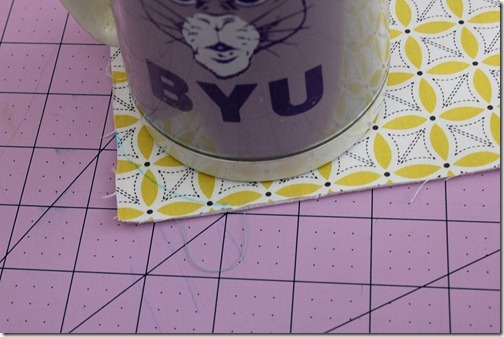 On both your exterior and interior fabrics you will trace a rounded edge. Do this using a mug, cup or something else round, line it up so it just touches the edges of the fabric. Using a disappearing ink or water soluble marker, trace around the curve of your object. Do this to two corners of the front body pieces (the small horizontal rectangle) of both fabrics (the top corners won’t be rounded.) Round all four corners on your back body pieces (the big vertical rectangle.) Cut along the lines with scissors.
On both your exterior and interior fabrics you will trace a rounded edge. Do this using a mug, cup or something else round, line it up so it just touches the edges of the fabric. Using a disappearing ink or water soluble marker, trace around the curve of your object. Do this to two corners of the front body pieces (the small horizontal rectangle) of both fabrics (the top corners won’t be rounded.) Round all four corners on your back body pieces (the big vertical rectangle.) Cut along the lines with scissors. 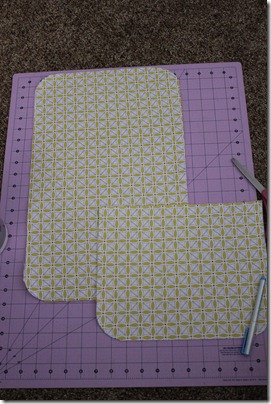 Hopefully this picture illustrates that well enough.
Hopefully this picture illustrates that well enough.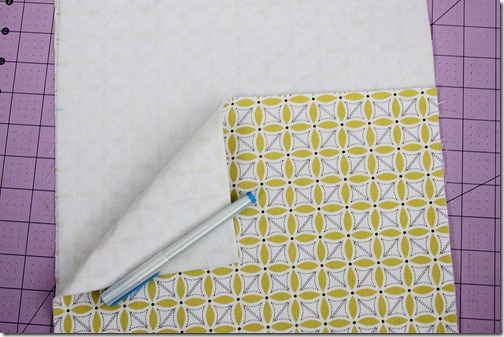 Put your smaller front piece over the top of your bigger back piece and line up their bottom edges. Make a mark on your back piece at the very top of your front piece. Do this to both sides. I show marking on the backside, but it really needs to be on the front side. Sorry.
Put your smaller front piece over the top of your bigger back piece and line up their bottom edges. Make a mark on your back piece at the very top of your front piece. Do this to both sides. I show marking on the backside, but it really needs to be on the front side. Sorry.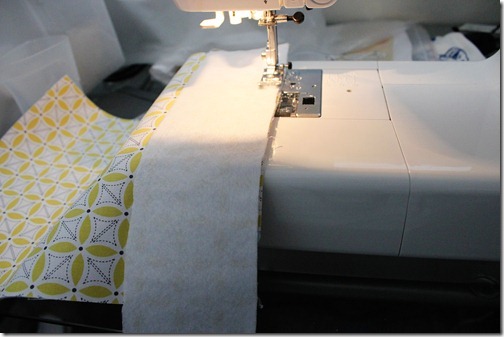 With right sides together, sew your side piece to your smaller front piece. I really should tell you to pin. But I didn’t pin. I try to avoid it. The rounded corners can be a little tricky, so if you’re not comfortable sewing rounds I would recommend pinning before sewing. It’ll make you happier.
With right sides together, sew your side piece to your smaller front piece. I really should tell you to pin. But I didn’t pin. I try to avoid it. The rounded corners can be a little tricky, so if you’re not comfortable sewing rounds I would recommend pinning before sewing. It’ll make you happier.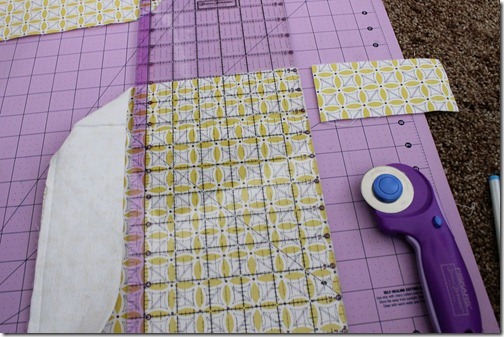 After you get all the way around your front piece, lay it on your cutting board and trim off the excess fabric. I gave a little bit of extra just in case it didn’t line up just right after sewing the corners.
After you get all the way around your front piece, lay it on your cutting board and trim off the excess fabric. I gave a little bit of extra just in case it didn’t line up just right after sewing the corners.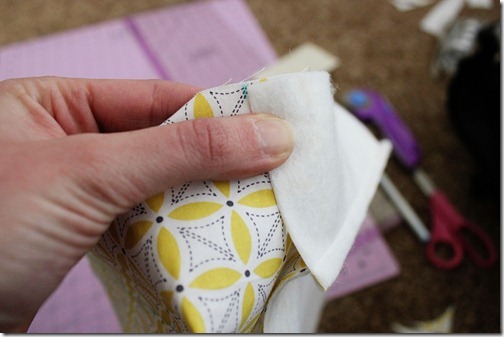 Sorry this really is not the best illustrating picture. You need to take your side piece (which is now sewn to your front piece) and with right sides together, match it up with the mark you made on your back piece. Pin it in place so it doesn’t move, or hold it really tight and get it under the presser foot as fast as you can (like I do.) Pin your back piece to your side piece. Sew all the way around. The other edge of your side piece should match up with the other mark you made on the back piece. Or at least be pretty darn close.
Sorry this really is not the best illustrating picture. You need to take your side piece (which is now sewn to your front piece) and with right sides together, match it up with the mark you made on your back piece. Pin it in place so it doesn’t move, or hold it really tight and get it under the presser foot as fast as you can (like I do.) Pin your back piece to your side piece. Sew all the way around. The other edge of your side piece should match up with the other mark you made on the back piece. Or at least be pretty darn close.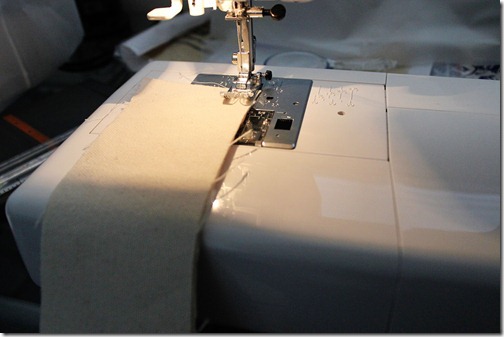 Now to sew your strap. I did it the hard way. With right sides together I sewed the two strap pieces straight down either side. Then I had the dreaded tube to turn right side out. I chose to do this because I think it just looks nicer than the alternative (which I’ll explain), but holy cow it that heavyweight fabric was extra difficult to turn right side out! Instead of sewing a tube, you can use your iron to press the edges down 3/8 inch and sandwich your two pieces together with wrong sides touching (so the right side is facing you.) Then topstitch them into place.
Now to sew your strap. I did it the hard way. With right sides together I sewed the two strap pieces straight down either side. Then I had the dreaded tube to turn right side out. I chose to do this because I think it just looks nicer than the alternative (which I’ll explain), but holy cow it that heavyweight fabric was extra difficult to turn right side out! Instead of sewing a tube, you can use your iron to press the edges down 3/8 inch and sandwich your two pieces together with wrong sides touching (so the right side is facing you.) Then topstitch them into place.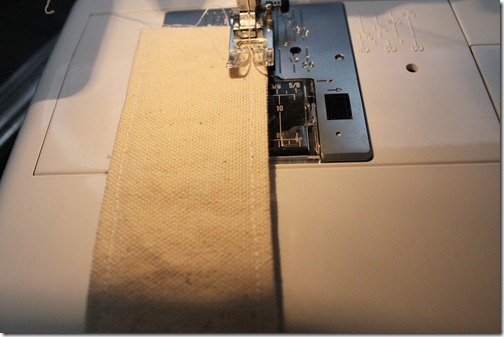 After turning your tube, iron the strap flat and then topstitch to keep it tight and secure. I topstitched at 1/4 inch.
After turning your tube, iron the strap flat and then topstitch to keep it tight and secure. I topstitched at 1/4 inch.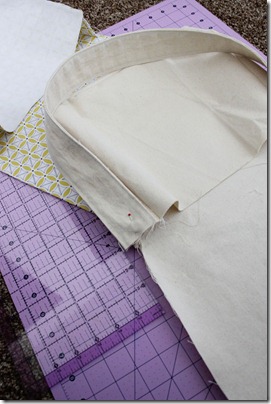 Pin the strap to your outer bag.
Pin the strap to your outer bag.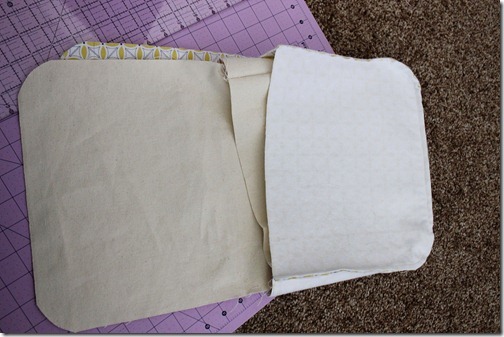 With your outer bag right side out and your lining inside out, stuff your outer bag into your lining. The right sides of the fabric should be touching.
With your outer bag right side out and your lining inside out, stuff your outer bag into your lining. The right sides of the fabric should be touching. 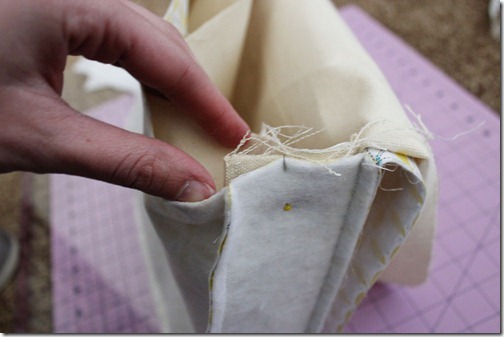 To keep the strap extra secure so it doesn’t shift while you sew, pin it to the lining as well. The strap itself should be stuff in between your two fabrics right now. You don’t want it visible or it’ll end up on the inside of your bag!
To keep the strap extra secure so it doesn’t shift while you sew, pin it to the lining as well. The strap itself should be stuff in between your two fabrics right now. You don’t want it visible or it’ll end up on the inside of your bag!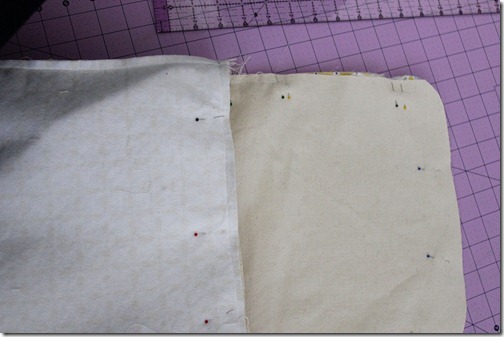 Now pin your bag together. I definitely recommend pinning for this step. Remember to leave a few inches open so you can reach inside and turn the whole bag right side out. I placed double pins on the side of the flap to remind myself to stop before I sew the whole thing shut. Stitch all the way around the bag until you get to your gap where you’re going to turn it right side out.
Now pin your bag together. I definitely recommend pinning for this step. Remember to leave a few inches open so you can reach inside and turn the whole bag right side out. I placed double pins on the side of the flap to remind myself to stop before I sew the whole thing shut. Stitch all the way around the bag until you get to your gap where you’re going to turn it right side out.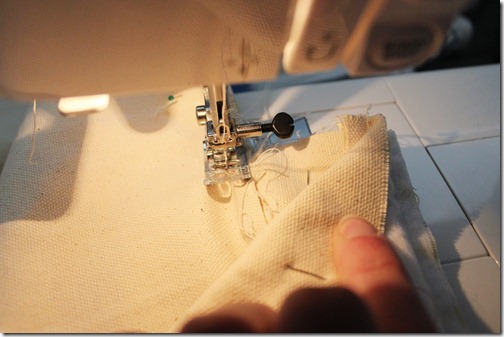 When you get to the spot where you’re sewing on the flap and turning to sewing onto the side of the bag, this part can be a little tricky. This is the one part of the bag I haven’t nailed down yet. Sew about 3/8 inch past the top of the side, leave your needle in the fabric, lift the presser foot and pivot your fabric so you’re sewing across the side. It’s a little bit awkward and there’s a little bit of bunching fabric.
When you get to the spot where you’re sewing on the flap and turning to sewing onto the side of the bag, this part can be a little tricky. This is the one part of the bag I haven’t nailed down yet. Sew about 3/8 inch past the top of the side, leave your needle in the fabric, lift the presser foot and pivot your fabric so you’re sewing across the side. It’s a little bit awkward and there’s a little bit of bunching fabric.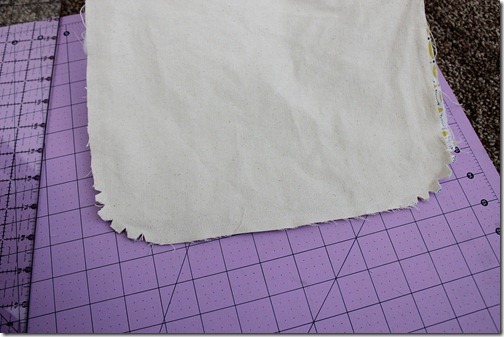 After you sew all around the edges, notch the rounded corners on the flap. Turn the bag right side out! You’re almost done!
After you sew all around the edges, notch the rounded corners on the flap. Turn the bag right side out! You’re almost done!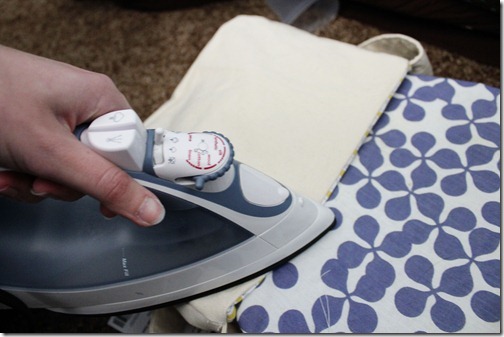 Iron the bag edges, turning the unsewn portion in.
Iron the bag edges, turning the unsewn portion in. Topstitch all around the bag edges.
Topstitch all around the bag edges.